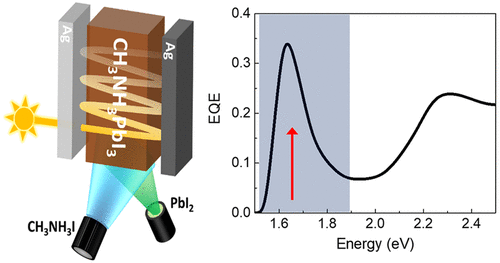当前位置:
X-MOL 学术
›
ACS Photonics
›
论文详情
Our official English website, www.x-mol.net, welcomes your feedback! (Note: you will need to create a separate account there.)
Vacuum-Deposited Microcavity Perovskite Photovoltaic Devices
ACS Photonics ( IF 7 ) Pub Date : 2021-06-18 , DOI: 10.1021/acsphotonics.1c00389 Abhyuday Paliwal 1 , Chris Dreessen 1 , Kassio P. S. Zanoni 1 , Benedikt Dänekamp 1 , Beom-Soo Kim 1 , Michele Sessolo 1 , Koen Vandewal 2 , Henk J. Bolink 1
ACS Photonics ( IF 7 ) Pub Date : 2021-06-18 , DOI: 10.1021/acsphotonics.1c00389 Abhyuday Paliwal 1 , Chris Dreessen 1 , Kassio P. S. Zanoni 1 , Benedikt Dänekamp 1 , Beom-Soo Kim 1 , Michele Sessolo 1 , Koen Vandewal 2 , Henk J. Bolink 1
Affiliation

|
The interaction between semiconductor materials and electromagnetic fields resonating in microcavities or the light–matter coupling is of both fundamental and practical significance for improving the performance of various photonic technologies. The demonstration of light–matter coupling effects in the emerging perovskite-based optoelectronic devices via optical pumping and electrical readout (e.g., photovoltaics) and vice versa (e.g., light-emitting diodes), however, is still scarce. Here, we demonstrate the microcavity formation in vacuum-deposited methylammonium lead iodide (CH3NH3PbI3, MAPI) p-i-n photovoltaic devices fabricated between two reflecting silver electrodes. We tune the position of the microcavity mode across MAPI’s absorption edge and study the effect on the microcavity absorption enhancement. Tuning the microcavity mode toward lower energies enhances the absorption of the lower energy photons and steepens the absorption onset which reduces the effective optical gap (Eg) of the devices. This leads to a reduction in the open circuit voltage deficit.
中文翻译:

真空沉积微腔钙钛矿光伏器件
半导体材料与微腔中谐振的电磁场之间的相互作用或光-物质耦合对于提高各种光子技术的性能具有基础和实际意义。然而,通过光泵浦和电读出(例如光伏)和反之亦然(例如发光二极管)在新兴的基于钙钛矿的光电器件中的光-物质耦合效应的演示仍然很少。在这里,我们展示了真空沉积的甲基碘化铅(CH 3 NH 3 PbI 3, MAPI) pin 光伏器件制造在两个反射银电极之间。我们调整微腔模式在 MAPI 吸收边缘的位置,并研究对微腔吸收增强的影响。将微腔模式向较低能量调整可增强较低能量光子的吸收并使吸收开始变陡,从而减小器件的有效光学间隙 ( E g )。这导致开路电压不足的减少。
更新日期:2021-07-21
中文翻译:

真空沉积微腔钙钛矿光伏器件
半导体材料与微腔中谐振的电磁场之间的相互作用或光-物质耦合对于提高各种光子技术的性能具有基础和实际意义。然而,通过光泵浦和电读出(例如光伏)和反之亦然(例如发光二极管)在新兴的基于钙钛矿的光电器件中的光-物质耦合效应的演示仍然很少。在这里,我们展示了真空沉积的甲基碘化铅(CH 3 NH 3 PbI 3, MAPI) pin 光伏器件制造在两个反射银电极之间。我们调整微腔模式在 MAPI 吸收边缘的位置,并研究对微腔吸收增强的影响。将微腔模式向较低能量调整可增强较低能量光子的吸收并使吸收开始变陡,从而减小器件的有效光学间隙 ( E g )。这导致开路电压不足的减少。

























 京公网安备 11010802027423号
京公网安备 11010802027423号